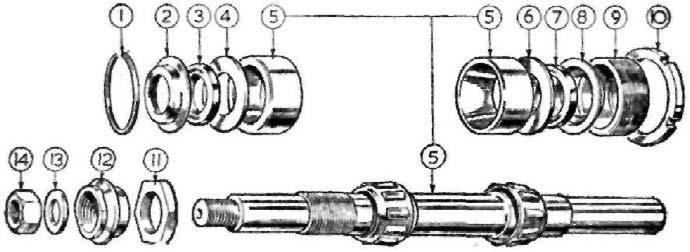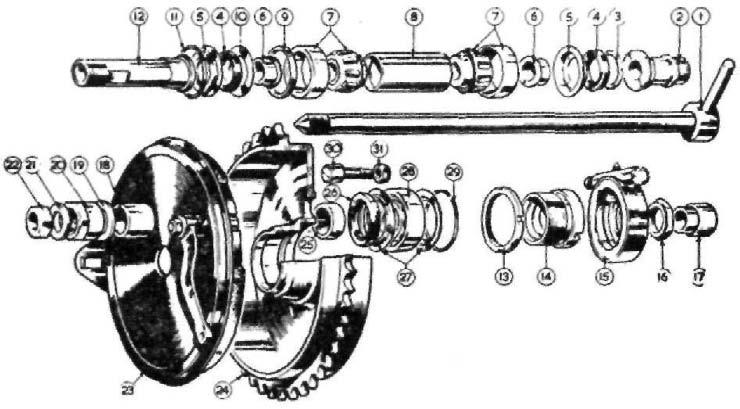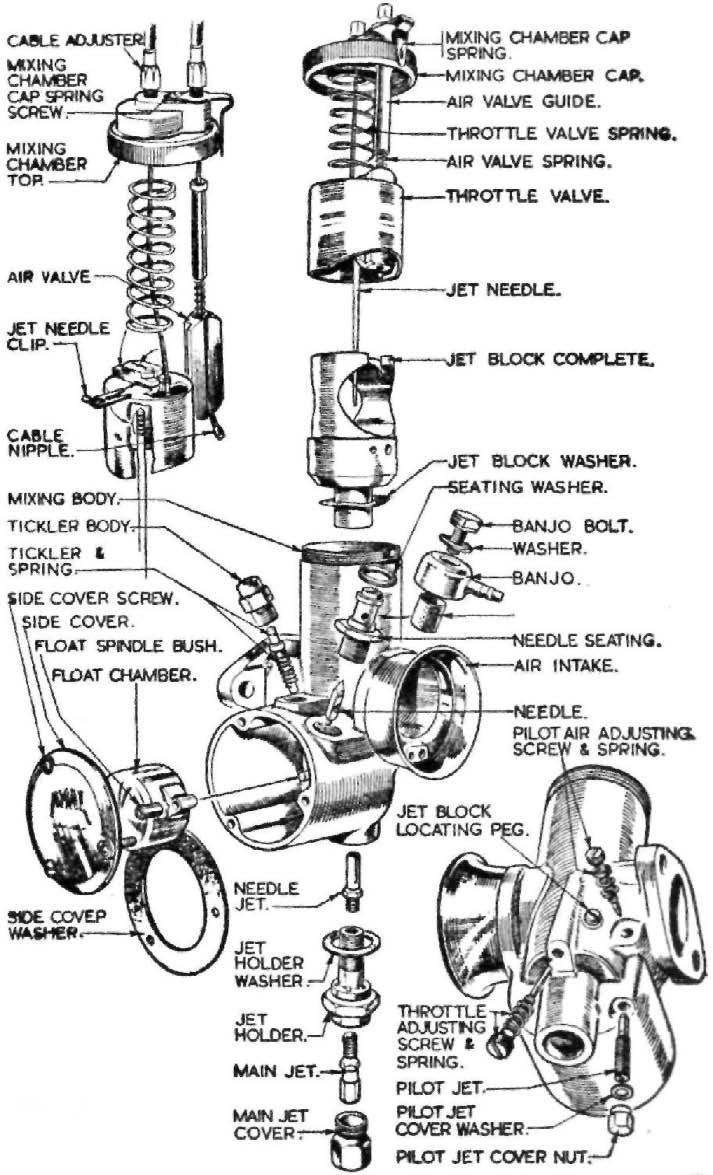
9 minute read
Wipac electrical service
mechanically identical and will interchange, the switch knobs being differently marked. If one switch is suspect, take off the lamp rim and glass. Pull off the cable plugs and reverse their location. A further check will indicate if the switch is defective or otherwise. Replace the cable plugs in correct position after changing the switch.
Replacement switches should be of the improved type which can be identified by a NYLON post for the switch knob. Old type switches use a steel post. Plug location. The blue plug is for the lighting system and the black for ignition.
WIPAC ELECTRICAL SERVICE
Lamp bulb 'blowing'. Premature bulb failure involving all or many of the light bulbs at one time on a full d.c. battery system is caused by a defective connection in the battery 'line'.
This 'line' starts at the frame end of the translucent lead from the positive battery terminal and proceeds: (2) Positive battery terminal. (3) Negative battery terminal. (4) Brown wire from battery negative to 4-hole connector (bullet terminal). (5) Brown wire from 4-hole connector to ammeter (bullet terminal). (6) Ammeter terminal with brown wire. (7) Ammeter terminal with blue wire. (8) Both ends of short insulated link wire in the ignition switch plug, which joins blue ammeter wire to brown wire going to lights switch.
Should the ammeter develop internal open circuit, bulbs will blow, also should the battery have little or no electrolyte, this is a partial or complete open circuit with the same results. There is finally the remote possibility af one of the actual wires in the battery 'line' being broken—again, bulbs will 'blow'.
For quick checking, test connections in this order: (1) Both battery terminals. (2) Both ammeter terminals. (3) All brown wires into 4-hole connector. Speedometer bulb. On models made before 1961, the speedometer bulb is in circuit during daylight running and fails from filament fatigue. Transfer the wire attached to the speedometer bulb holder and connect it to the light switch as shown in wiring diagram for 1962 models, to illuminate the speedometer when lights are in use. Ignition system. SPECIAL NOTE— The star-shaped washer for contact breaker pivot is not detachable. If the engine fails to start and there is no spark at the sparking plug points, examine the contact breaker by:
Check the gap at full separation .012" and reset if necessary (ensure feeler gauge is free from oil),
Check conditions of contact points which should have a grey frosted condition. The presence of oil or grease in the contact breaker compartment will cause a black matt condition.
Clean points with an abrasive strip or alternatively fine grade emery cloth. Pass a strip of clean paper, or rag soaked in petrol, across the points after cleaning.
Check free movement of contact breaker arm on its pivot, Adjusting contact breaker gap. This adjustment is effected by altering the position of the plate for the fixed contact point by: (1) Releasing slightly the locking screw. (2) Adjust the gap by turning the eccentric screw (close to the fibre pad) in the required direction, with the fibre pad on the rocker arm on the cam lobe (maximum separation) .012". Retighten the lock screw when adjustment is correct. Lubrication. The felt pad should be impregnated with H.M.P. grease. Use sparingly, an excess can affect contact points surface.
Before replacing the contact breaker cover, check the condenser fixing for security.
If attention to the contact breaker fails to produce a spark, check the circuit by:
Switch on the ignition, rotate the engine very slowly until the contact points close. A discharge between three to four amps will be shown on the ammeter if current is passing,
As the ammeter is not closely calibrated, a more accurate check can be made by using the d.c. ammeter in between the brown battery wire and its connector.
If a discharge is not shown on the ammeter with contact points closed, this indicates current is not passing through the primary windings in the h.t. coil.
With ignition switch on check the dark green wire attached to the coil by:
Removing this wire from the coil terminal.
Connect one side of the d.c. voltmeter to the end of the dark green wire, the other side of the meter to earth.
If there is no reading on the meter, check the ignition (black) plug in the headlamp.
If the interna] insulated wire bridge across two of the plug terminals (see wiring diagram) is fractured or disconnected, this will allow the engine to start with the switch on either emergency or ignition, but not in both positions, as one switch connection is out of circuit.
Renew the bridge connection. Ignition coil test. (1) Use a battery with one wire attached to the d.c. voltmeter with a short length of wire attached to the other voltmeter terminal. (2) Disconnect the two wires attached to the coil, also the h.t. cable. (3) Use a further wire on the second battery terminal. Connect the free end of this wire, also the meter wire across the coil terminals. If there is continuity, a reading will show on the meter indicating the primary winding is in order. (4) Transfer one wire from the coil terminal to the centre h.t. connection, if there is continuity a lower voltage reading will show by reason of the higher resistance of the secondary winding.
(5) Place one of the rest wires on to one of the two coil terminals, the other to the coil case. No reading should show. Use the test wires on the h.t. connection and the case. No reading should show.
A meter reading on one or both tests means the windings are earthed, the coil should be replaced.
Usually a defective primary winding will produce a weak spark, conversely, an intermittent spark is associated with a faulty secondary winding. Where doubt exists, test by substitution. The condenser (see 'Ignition system'). If the condenser is suspect, use a sound condenser with two crocodile clips attached to it.
Remove contact breaker cover, attach one clip to the connection on the contact breaker terminal, the other to a conventional earth position.
Running the engine with the external condenser in use will prove if the condenser is faulty or otherwise.
Vivid blue arcing at the contact points is indicative of a faulty condenser.
Where the orthodox electrical testing gear is not available, improvisation can be made using the following equipment: (1) A 6 volt 36 watt bulb and holder. (2) A ft volt .04 amp bulb and holder (this bulb is used on cycle rear lamps). (3) A fully charged 6 volt battery. (4) A short length of wire to join the battery to one side of the bulb holder. Also two test wires about 24" long connected to the other battery and bulb holder terminals.
Test to ensure the bulb lights then proceed by:
Join one test lead to the white cable, the other test wire to the green cable.
Run the engine at a fast tick over speed when the bulb should show a fairly bright light.
Transfer the test wire from the green cable only to the orange cable and repeat the test. Conclusions from test (1) If the lamp bulb is not uniformly lighted on both tests, there is a fault in the alternator (see 'Earth test'). (2) Should the bulb fail to light, the alternator is defective. (3) A dull light on both tests indicates a partially demagnetised rotor, due to battery connections being reversed at some time or other. Use a.c. voltmeter to check voltage output. Alternator coils earthed. Use the test set with the 6 volt .04 bulb.
Connect one test wire to a convenient earth position on the engine.
Connect in turn, the other test wire to the white, green and orange wires,
Should the bulb light on any of these tests, the coils are shorted to earth. Rectifier (forward flow test). With the ignition and lights switches 'OFF', use the 36 watt bulb for this test, then;
Disconnect the wire from the brown connector on the rectifier (keep
the wire end clear of the frame and engine).
Connect one test lead to rectifier brown terminal, the other test lead to earth.
Switch on to EMG and run the engine at tickover when, if the rectifier is O.K., the bulb will light brightly (six coils in circuit).
Repeat the test with the switch at IGN {three coils in circuit), the bulb will light, but not so brightly if rectifier is O.K. Warning: Do not attempt to run the engine with an open circuit for the rectifier. The brown wire or the test set must be connected to prevent high voltage which will cause damage. Rectifier (reverse flow test). With the light and ignition switches 'OFF' test by:
Taking off one of the battery wires from the battery.
Connect the test set with the .04 amp bulb between the battery terminal and the battery wire.
If the reverse flow is normal, the bulb will light dimly, a bright Light indicates a defective rectifier, Alternative rectifier tests. An alternative method of testing can be effected by using the following equipment: (1) A moving coil ammeter, scale 10-0-10. (2) A fully charged 6 volt battery, (3) A 6 volt 30 watt lamp bulb and holder. (4) A 6 volt 0.04 amp bulb and holder. (5) Three short test wire. Forward flow test. Make a series circuit. The bulb will light with a reading of approximately 4.5 amps on the meter.
Take off the wire from the positive battery terminal, connect the third test lead to the positive battery terminal, also to the brown terminal on rectifier (d.c. negative).
Take up the wire taken from the battery and connect in turn to the green, then white, terminals (a.c. side).
For clarity, remove test wires from rectifier, remake the series circuit.
Next remove the battery negative wire, connect the third test wire to the negative battery terminal, also to the rectifier earth bolt or case.
Connect in turn the wire removed from the battery to the green and white terminals. Again, in each test the bulb should light with a reading of 4.5 amps.
If the meter readings on these tests are above 3 amps, the rectifier is satisfactory. Discard the rectifier if the readings are below 3 amps. NOTE—Whilst a new rectifier will show 4.5 amps, this value will decrease after considerable service. Reverse flow test. Make a circuit using .04 amp bulb for this test.
A rectifier that is normal will have a reverse flow which should not exceed 0.040 milliamps, by using the 0.40 bulb with a current consumption of 40 milliamps it can be established if the reverse flow is abnormal by:
Removing the positive lead from the battery.





